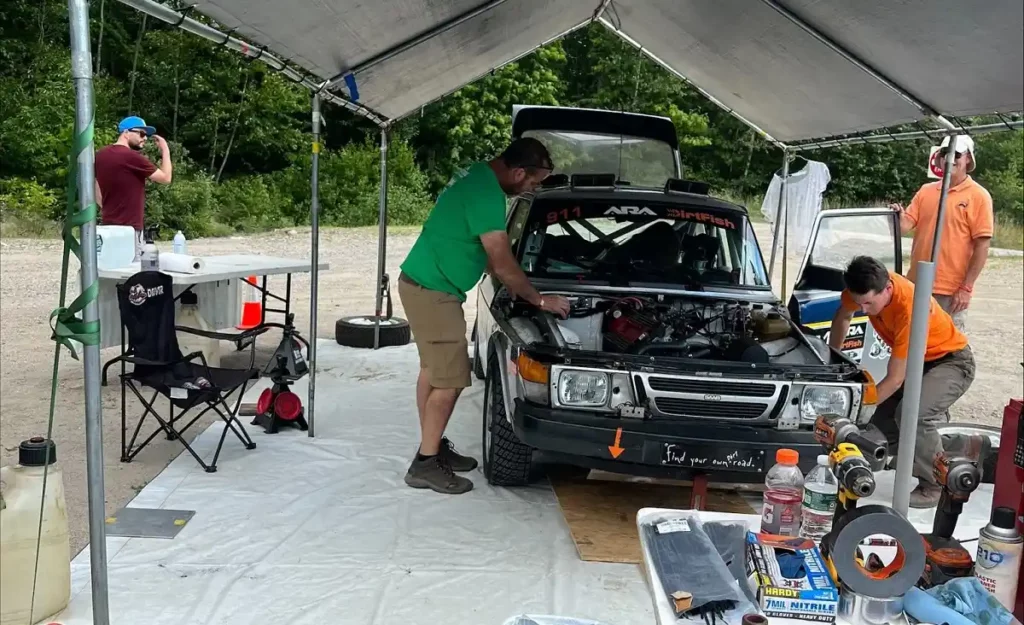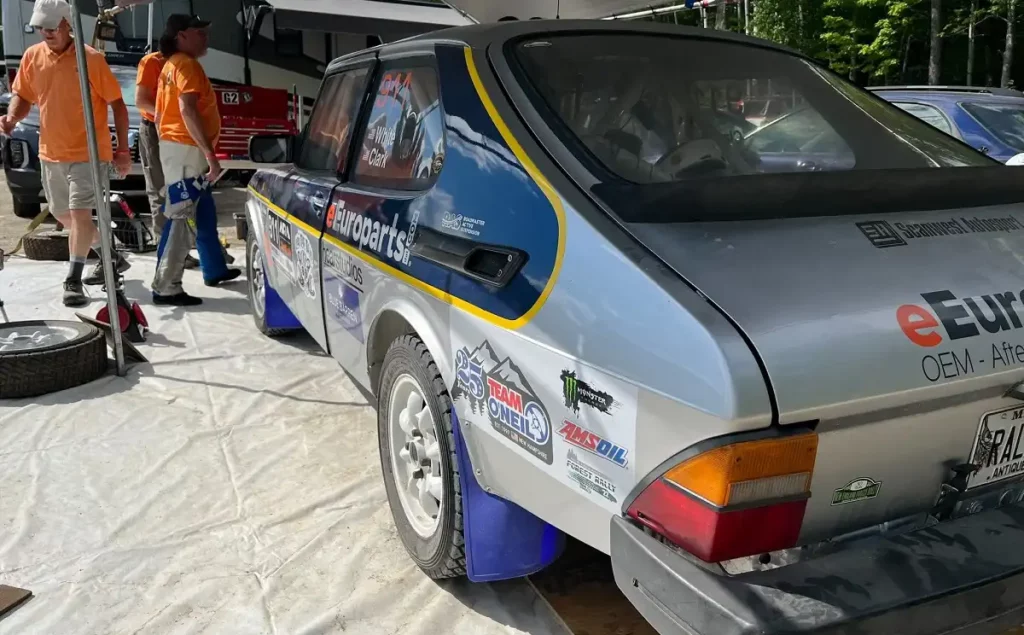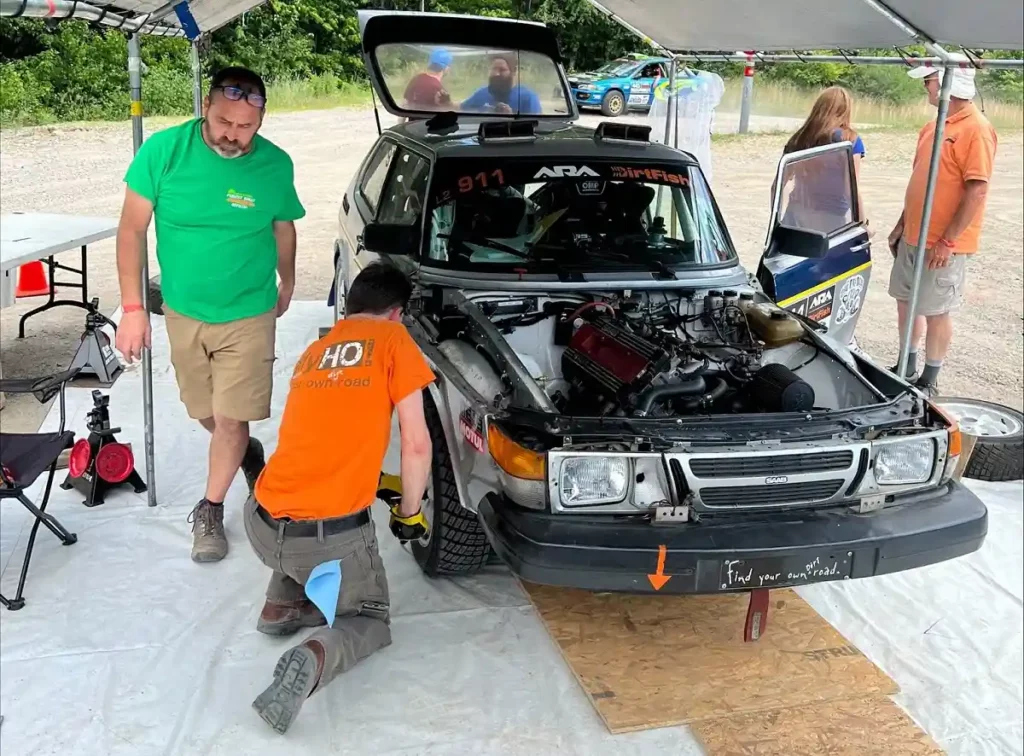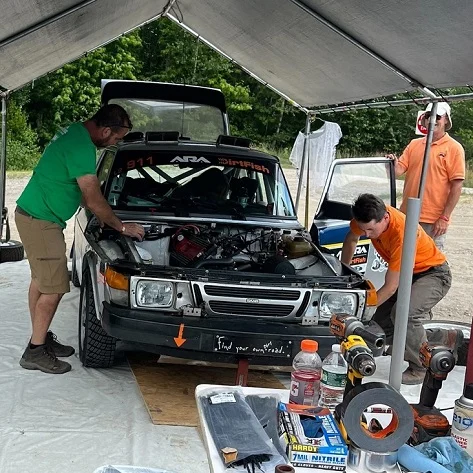It’s the middle of July, and for the residents of Newry, ME, that means only one thing — the New England Forest Rally is about to commence. Just like last year, eEuroparts.com once again has the pleasure of sponsoring Mike White and Geoff Clark of RallyHo! Motorsports in their attempt to pit their SAAB 900 against newer machinery in the 2WD Limited class of the 2022 NEFR event.
The team posted competitive times last year before some mechanical issues relegated them to 5th place. The lessons learned at the 2021 NEFR have allowed them to fine-tune their contingencies in the hopes they are better prepared for the unknown. An important part of said preparations comes in the form of new modifications to White’s SAAB. Here’s what’s new on the car.

Photo courtesy of Chuck DeBlois
New Modifications and Minor Changes
Mike White’s dolled-up SAAB 900 rally car is anything but typical. The story behind it and its original mods is proof that thinking outside the box can yield impressive results, even if you’re working with an unorthodox choice for a rally car. You can check the full rundown of the build in our last year’s report.
The car features a stock engine paired with a highly modified and custom fabricated suspension. Most other systems, like the fueling and steering, have been modified to meet motorsports requirements. After all, this is a proper rally car.
Where most teams focused on extracting more wheel horsepower from their car, Team RallyHo! had decided to take a different approach. Their idea was to improve the fidelity of the SAAB 900 platform and only add more power once the car is fully dialed in. Coming in 5th in a very competitive 2WD class last year, gives credence to this approach. With a few more tweaks, White’s SAAB 900 is ready to continue pushing towards the top of the leaderboard.
The newly added changes to the car aren’t drastic. Most of the systems were already fine-tuned, only needing minor adjustments. Under the hood, the only thing that changed was a new cooling package that we’ll discuss later on, and the addition of reinforced engine mounts. Beefier mounts will prevent the engine from leaning too far and placing more load on the tripod bearings.
Suspension Fine-Tuning

The suspension system saw no major changes, Team RallyHo! Motorsports had ordered a set of ProParts control arms from the eEuroparts.com store, which they’ve then reinforced to replicate the design they’ve already been using on the car for the last 12 years.
The Bilstein shock absorbers and spring combo have remained the same. That entire setup was meticulously engineered and implemented before the last year’s event, where it has proven to be more than effective. The only new thing were the custom-made spacers that were added to the bump stops.
The team wanted to engage the bump stops sooner, but in a progressive manner. To help with that, the new spacers position the bump stops further into the shock’s travel. As a result, the car should be better equipped to deal with the often treacherous terrain of Western Maine/Northern New Hampshire logging tracks.
Accent on the Cooling Package

Photo courtesy of Chuck DeBlois
One area of the car that did see a lot of improvement was the cooling package. The team obtained a new Nissens radiator from eEuroparts.com and oil coolers for the engine as well as the transmission. This gives the already balanced stock powertrain even more headroom as far as thermal management goes.
Included in these upgrades was a small cooler for the power steering system. The loss of power steering during the last year’s event was due to a 37-year-old SAAB OEM oil cooler failing and has prompted RallyHo! Motorsports to come up with a better way to cool the power steering fluid. Eventually, the team found a small oil cooler built and certified for NASCAR use, which they then installed on the power steering circuit.
New Seats and Comms
Although rallying and comfort don’t go hand in hand, a good choice of bucket seats can make all the difference in the world during a long stage. The team went out and got a pair of OMP bucket seats which are far more comfortable than the ones they’ve been using before. Furthermore, the new seats made entering and exiting the car a lot easier thanks to a more efficient halo design.
Consistent lines of communication are essential in rallying. The link between the driver and the co-driver has to remain up, and it has to be clear. White and Clark experienced comms issues last year, which made navigation challenging to say the least. The two had to use hand signals to communicate for the rest of that particular stage.
This time around, the duo is running a new set of headsets for transits and a new Peltor intercom hardwired to the car’s battery making it the main power source. The new intercom offer better noise-canceling properties, as well as means to link the team’s radio comms straight into the helmet.
Testing the Mods In the Field
With everything set, the team has made their way to the event. By the time this article goes live, White and Clark have already driven the first day’s worth of stages.
We’re looking forward to a post-rally debrief with Mike White where we’ll find out how the new mods have fared in the field, while also getting a first-hand account of the entire event. Stay tuned for a more detailed interview with White and Clark in a few days!


